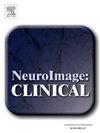半球脑卒中幸存者平衡与视觉空间注意的关系:自我中心与异位中心神经加工的研究
IF 3.6
2区 医学
Q2 NEUROIMAGING
引用次数: 0
摘要
背景:平衡和视觉空间注意力受损是中风的后遗症。然而,平衡功能和视觉空间注意力之间的相互作用,特别是在自我中心和非中心的参考框架中,仍然知之甚少。目的研究脑卒中患者左、右半球损伤后平衡感与视觉空间注意力之间的关系,并探讨其潜在的神经机制。方法17例右脑卒中患者、16例左脑卒中患者和18例年龄匹配的健康对照。使用Prokin评估平衡功能,而通过涉及自我中心和非中心参考框架的任务评估视觉空间注意力。此外,还测量了注意任务过程中P1、N1和P2分量的事件相关电位。结果左脑卒中患者的平衡性和视觉空间注意力表现优于右脑卒中患者。左脑卒中幸存者的平衡功能与自我中心和异中心视觉空间注意力表现呈正相关。在右半球卒中幸存者的异心加工过程中观察到P1振幅减弱和P2振幅增强。左半球脑卒中幸存者在平衡任务中,O2电极上的P2振幅与中侧向速度、椭圆面积和周长呈正相关。结论平衡功能与异心视觉空间任务的选择性注意和分类过程密切相关,特别是在左脑卒中患者中,提示右脑可能在轻中度卒中患者的平衡和视觉空间注意功能中发挥重要作用。本文章由计算机程序翻译,如有差异,请以英文原文为准。
The relationship between balance and visuospatial attention on hemispheric stroke survivors: A study of egocentric and allocentric neural processing
Background
Impaired balance and visuospatial attention are well-documented sequelae of stroke. However, the interplay between balance function and visuospatial attention, particularly within egocentric and allocentric reference frames, remains poorly understood.
Objective
This study aimed to elucidate the relationship between balance and visuospatial attention in stroke survivors with left- and right-hemisphere lesions and to investigate the underlying neural mechanisms.
Methods
Seventeen patients with right-hemisphere stroke, sixteen with left-hemisphere stroke, and eighteen age-matched healthy controls participated in this study. Balance function was evaluated using Prokin, while visuospatial attention was assessed through tasks involving egocentric and allocentric reference frames. In addition, event-related potentials of the P1, N1, and P2 components were measured during the attention tasks.
Results
Patients with left-hemisphere stroke exhibited superior balance and visuospatial attention performance compared to those with right-hemisphere stroke. Balance function was positively correlated with both egocentric and allocentric visuospatial attention performance in left-hemisphere stroke survivors. Attenuated P1 amplitudes and enhanced P2 amplitudes were observed during allocentric processing in right-hemisphere stroke survivors. The P2 amplitude at the O2 electrode was positively associated with medio-lateral velocity, ellipse area, and perimeter during balance tasks in left-hemisphere stroke survivors.
Conclusions
Balance function is closely linked to selective attention and categorization processes in allocentric visuospatial tasks, particularly in patients with left-hemisphere stroke, suggesting that the right hemisphere may play an important role in mediating balance and visuospatial attention functions in the patients with mild to moderate stroke.
求助全文
通过发布文献求助,成功后即可免费获取论文全文。
去求助
来源期刊

Neuroimage-Clinical
NEUROIMAGING-
CiteScore
7.50
自引率
4.80%
发文量
368
审稿时长
52 days
期刊介绍:
NeuroImage: Clinical, a journal of diseases, disorders and syndromes involving the Nervous System, provides a vehicle for communicating important advances in the study of abnormal structure-function relationships of the human nervous system based on imaging.
The focus of NeuroImage: Clinical is on defining changes to the brain associated with primary neurologic and psychiatric diseases and disorders of the nervous system as well as behavioral syndromes and developmental conditions. The main criterion for judging papers is the extent of scientific advancement in the understanding of the pathophysiologic mechanisms of diseases and disorders, in identification of functional models that link clinical signs and symptoms with brain function and in the creation of image based tools applicable to a broad range of clinical needs including diagnosis, monitoring and tracking of illness, predicting therapeutic response and development of new treatments. Papers dealing with structure and function in animal models will also be considered if they reveal mechanisms that can be readily translated to human conditions.
 求助内容:
求助内容: 应助结果提醒方式:
应助结果提醒方式:


